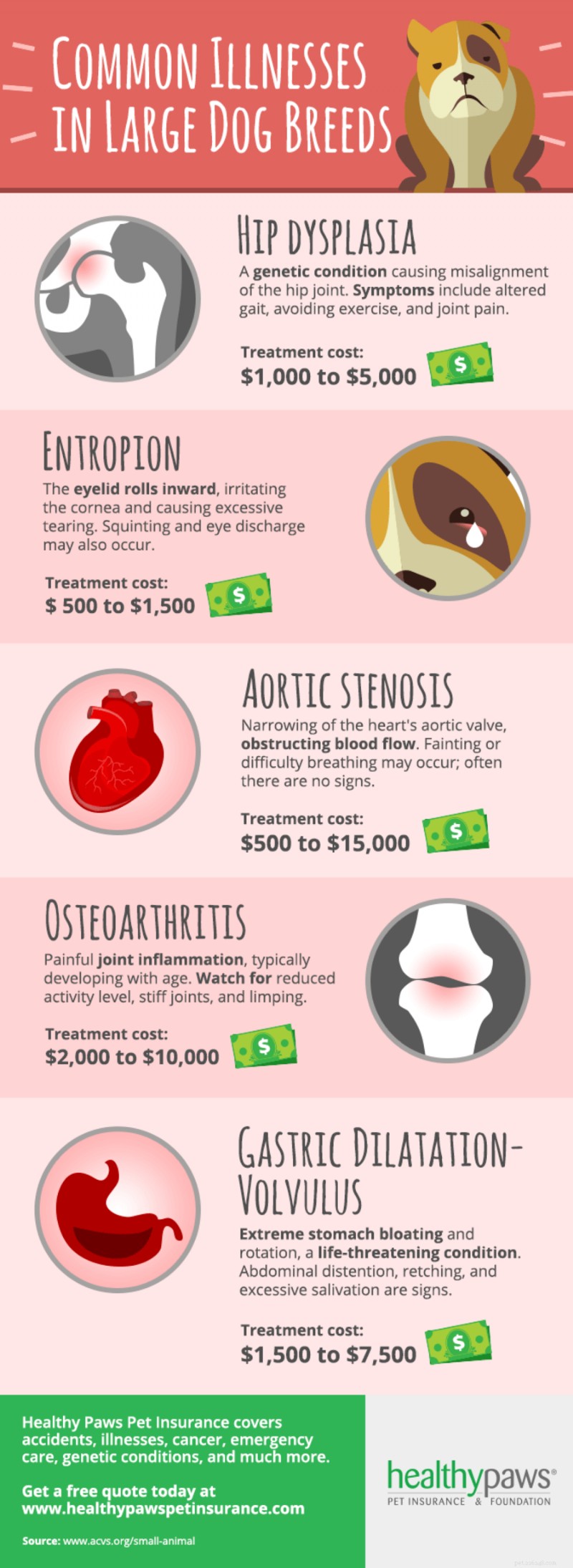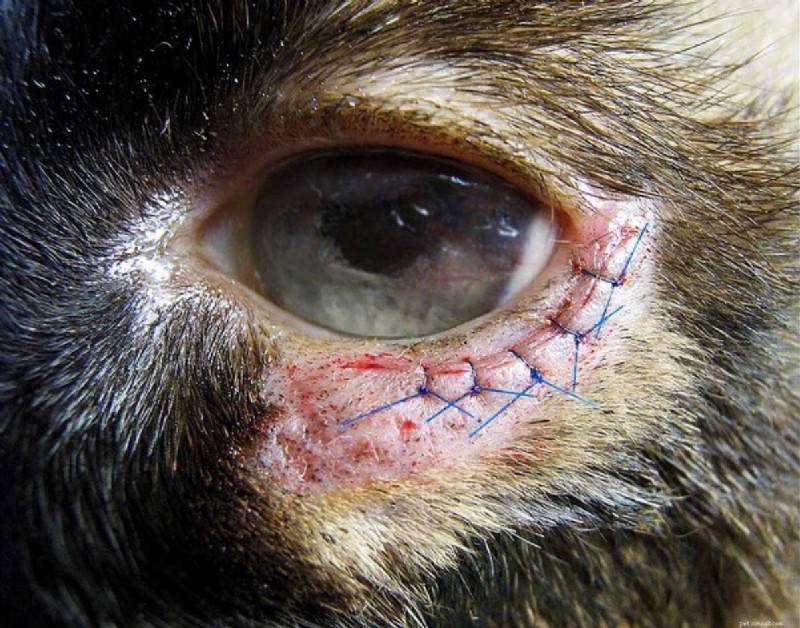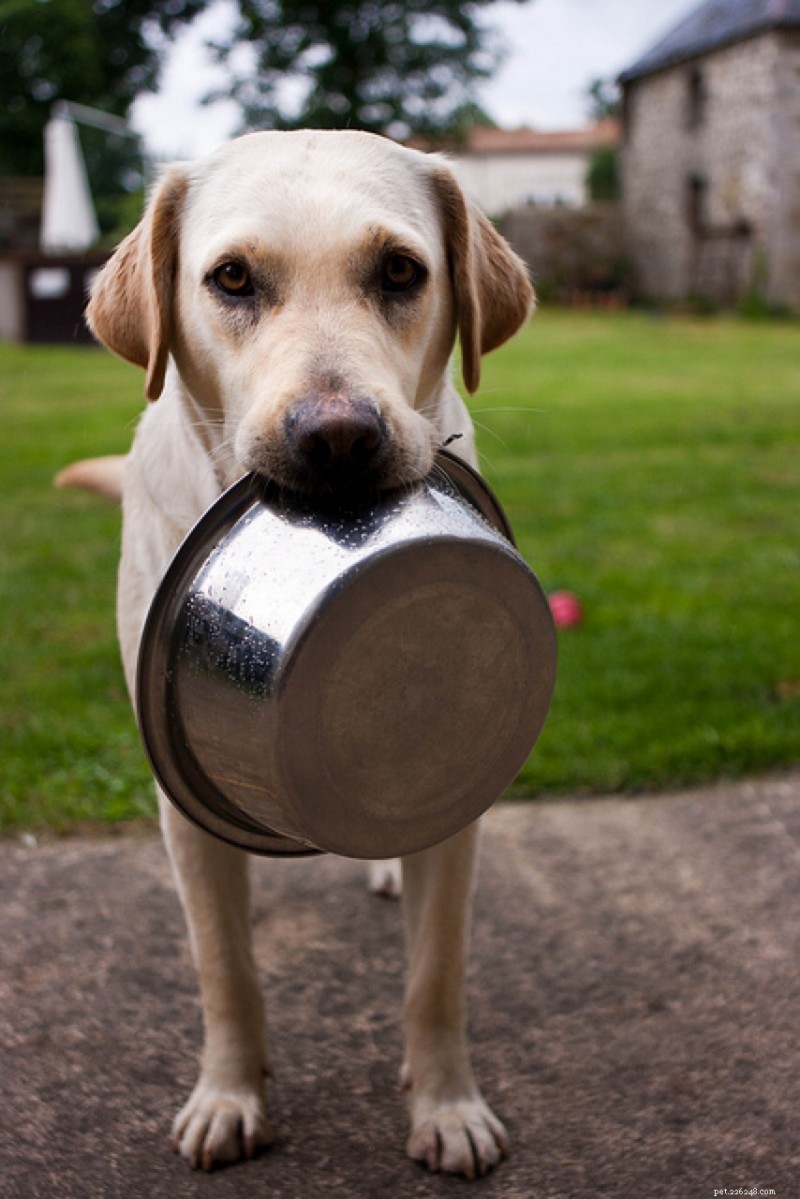Doenças comuns em raças de cães grandes
Revisado por JoAnna Pendergrass, DVM em 18 de outubro de 2022
Raças de cães grandes são os gigantes gentis do reino canino. Exemplos de raças de cães grandes ou chamadas “gigantes” incluem Great Danes, Pyrenees e Irish Wolfhounds. Esses filhotes têm muito amor para dar, mas com esses cães grandes vêm problemas de saúde maiores, geralmente envolvendo as articulações ou o coração.
Se você tem um desses cães de raças grandes, preste muita atenção à saúde e felicidade do seu animal de estimação, especialmente para animais de estimação idosos. Quaisquer alterações no nível de atividade, marcha ou respiração podem indicar a presença de uma condição médica que precisa de atenção veterinária.

Displasia da anca
Frequentemente ocorrendo em raças de cães grandes, a displasia do quadril é uma condição congênita que causa desalinhamento da articulação do quadril e do encaixe. De acordo com a Faculdade de Medicina Veterinária da Universidade de Cornell, a displasia da anca ocorre em até 50 por cento das raças de cães grandes; Bernese Mountain Dogs, Golden Retrievers, Pastores Alemães e Poodles Standard têm uma maior prevalência de displasia da anca.
O primeiro sinal de displasia coxofemoral em cães é a diminuição do nível de atividade. À medida que a doença progride, a dor nas articulações aumenta; os sintomas geralmente surgem entre quatro meses e um ano de idade. Cães com displasia da anca podem “pular de coelho” e também evitar correr ou subir escadas, o que agrava a dor nas articulações.
Se a displasia do quadril for detectada antes dos 10 meses de idade, a Orthopaedic Foundation for Animals recomenda uma osteotomia pélvica tripla, que pode reverter a subluxação precoce da articulação do quadril. Essa subluxação ocorre quando a cabeça do fêmur (osso da coxa) fica parcialmente deslocada de sua posição habitual no encaixe da articulação do quadril.
Animais de estimação mais velhos podem ter sucesso com uma substituição total do quadril – um procedimento caro não coberto por todas as apólices de seguro de animais de estimação. (Estamos orgulhosos em dizer que o plano Healthy Paws cobre displasia da anca não preexistente em todos os animais de estimação inscritos antes dos seis anos!)
Além das terapias cirúrgicas, medicamentos para a dor são frequentemente prescritos para reduzir a dor e o desconforto da displasia do quadril. Suplementos nutricionais, como condroitina e glucosamina, promovem a saúde das articulações. A fisioterapia também é benéfica.
Como a displasia da anca é hereditária, não pode ser prevenida em raças geneticamente predispostas a desenvolver a doença. However, keeping pups slim and trim, providing daily exercise, and feeding a nutritionally balanced diet promote good joint health in large dog breeds. Regular vet checkups allow your veterinarian to monitor your dog’s joints and start hip dysplasia treatment early if necessary.

Entropion
This painful medication condition is hereditary, causing the eyelid to roll inwards, irritating the eye. Entropion in dogs is not unique to large breed dogs, but is more common in larger dogs. Ectropion may also occur, where the eyelid rolls outwards.
If your dog has entropion, their eyes may excessively tear or blink and will appear red or inflamed. Pain leads dogs to paw at the affected eye, causing more damage.
Visit your vet for a diagnosis. Your vet will use a dye on your dog’s eyes to make any damage to the cornea visible. Entropion surgery is commonly used to correct the eyelid positioning and repair lacerations to the cornea. A “cone of shame” (Elizabethan collar) protects eyes post-surgery, which has a success rate of 90 to 95 percent, according to Michigan Ave Animal Hospital. Multiple surgeries may be required, but the prognosis for a full recovery is good in most pets.
Aortic Stenosis
Big dog breeds require big hearts to keep their blood pumping. Congenital heart conditions like aortic stenosis are common in large dogs, particularly Golden Retrievers. Large breed dogs like the Boxer, Newfoundland, and German Shepherd are also susceptible to the condition.
Aortic stenosis in dogs is the narrowing of the heart’s aortic valve, through which blood flows from the left ventricle to the aorta, and then to the rest of the body. This narrowing obstructs the flow of blood, forcing large dogs’ hearts to pump even harder. Symptoms include a cough, difficulty breathing, fainting, or exercise intolerance. Often there are no symptoms.
After determining the severity of the dog’s heart murmur (abnormal heart rhythm), further testing will be done to detail the condition of the heart. In severe aortic stenosis, surgery and/or beta-blocker drugs, which slow the heart rate, may be required. Pets with mild cases of the disease should avoid intense exercise, especially in hot weather, and stay slim.
Osteoarthritis
Also common in elderly pets, osteoarthritis is a degenerative joint disease – dogs’ joint cartilage decreases over time, causing intense pain due to bone-on-bone rubbing. There are several types of arthritis in dogs, some caused by cancer or infections; osteoarthritis arises in large dog breeds because of the high stress placed on joints.
Dogs suffering from osteoarthritis will limp as their joint pain increases. Bony growths often occur on joints, leading to swelling; in severe cases of osteoarthritis, joints will audibly grate when the animal moves.
Treatment of arthritis in dogs typically begins with non-steroidal anti-inflammatory drugs (NSAIDs) or steroids. The side effects of these medications can be rough on pets’ digestive systems, so they are not a long-term treatment method. Several types of surgery are effective for repairing or replacing the joint; amputation is considered in severe cases. Lifestyle changes are also recommended to further provide pain relief for dogs with osteoarthritis. Weight loss relieves pressure on pained joints, while glucosamine for dogs is a joint supplement often recommended by vets.

Gastric Dilatation-Volvulus
Also known as gastric torsion, this condition is most often seen in extra-large and deep-chested dog breeds due to the shape of their chests. Gas builds up in the stomach, which expands dangerously in large dogs’ deep chest cavities. Overeating or eating too quickly is thought to be a main culprit of excessive stomach gas; speedy eaters often gulp down a side of air with their meal. Danger happens when the stomach twists, obstructing blood flow by compressing blood flow – a life-threatening condition.
Retching, abnormal heart and breathing rates, excessive salivation, and a distended abdomen are the primary signs of GDV. As the vena cava, a large vein in the body, continues to be compressed, symptoms of shock, such as pale mucous membranes and unconsciousness, occur.
Emergency treatment focuses primarily on stabilizing the pet, decompressing the stomach, and reversing any torsion or twisting that occurred. Gastropexy, a surgical procedure during which the stomach is attached to the body wall to prevent twisting, is often performed in dogs with GDV.
With speedy treatment, large dogs have a good prognosis. Prevent GDV by monitoring your pet during meal times, making sure they don’t eat too quickly or too much at one time. Elevated food bowls help slow down eating.
The content is not intended to be a substitute for professional veterinarian advice, diagnosis, or treatment. Always seek the advice of your veterinarian or other qualified health provider with any questions you may have regarding a medical diagnosis, condition, or treatment options.
(Featured image via Flickr.com/tracyleephoto)
- Raças de cães alemães
- 13 sinais mais comuns de alergias em cães
- Grande – Raças de cães gigantes – Dica para animais de estimação 164
- Lesão comum em cães – Roturas ligamentares
- 10 dos problemas de saúde mais comuns em cães de raças grandes
- Raças de cães grandes:mais para amar!
- Raças de cães para crianças

